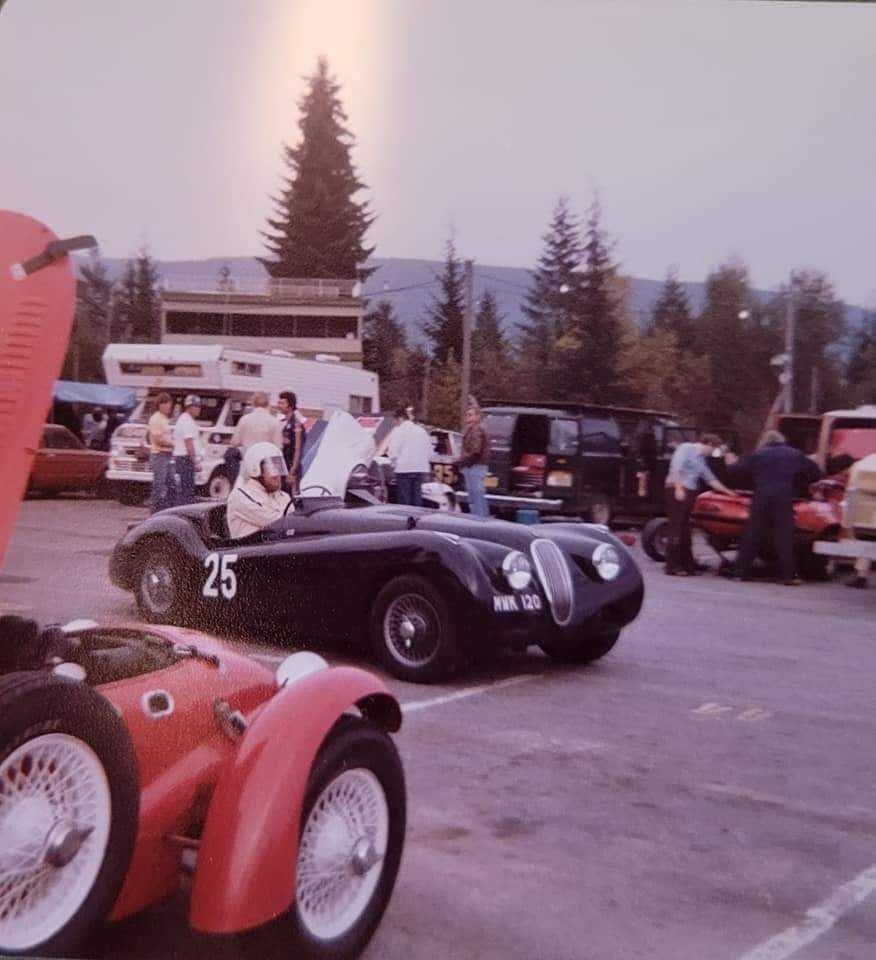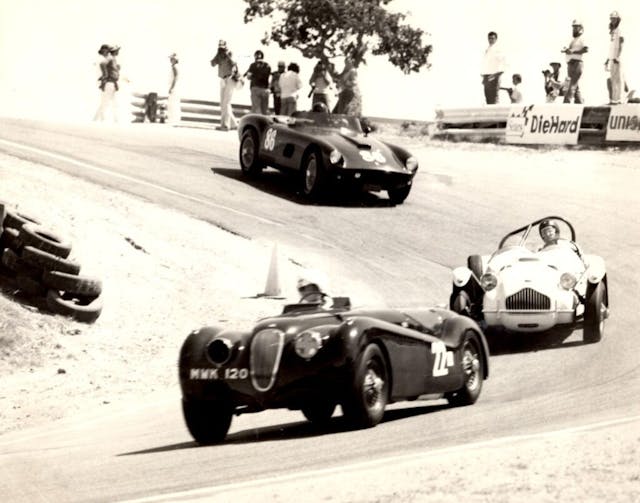The Strange Tale of the Fastest XK120 of Them All
There were plenty of stories to watch at the 1950 running of the 24 Hours of Le Mans, not least of them the first arrival of an American competitor, Briggs Cunningham, who had entered two Cadillacs. Perhaps most carefully watched, though, was the storyline of the Jaguars. It was the Le Mans debut for the marque, and three factory-prepped XK120s took to the field, each in the hands of a privateer team. Two of the three cars finished the race, and the third acquitted itself well before retiring. Everyone expected Jaguar to be back the following year—and it would be, with the now-famous C-Type. But months before entries were due for the 1951 race, head William Lyons shrewdly hedged his bets by building three special backup XK120s.
They were called the lightweight cars, LT for short, each one fitted with a magnesium alloy body. Intended as replacements should the C-Type not quite be ready to take on Le Mans in 1951, these three cars would go on to race only later, one of them coming to be known as the fastest XK120 of them all. Strangely, should you have been living in Vancouver, Canada in the 1960s or 1970s, you would have spotted the first of these special cars, either sitting exposed to the elements in an open carport on Southwest Marine Drive or just puttering off to get groceries, its owner seemingly unaware that he was driving a race-bred special worth perhaps seven figures.
The three lightweight XK120s were known as LT1, LT2, and LT3, but only the latter two were properly completed by the factory. When the C-Type turned out to be ready on time for Le Mans entry, LT2 and LT3 simply sat around for a while before passing into the hands of Charles Hornburg, Jr. of Los Angeles. Hornburg was the first to import Jaguars into the U.S., beginning in 1948, and he had a special relationship with the company—think of him as the West Coast version of Max Hoffman. A little wrangling between Hornburg and Lyons, and the two complete lightweight Jaguars headed to the United States.

Hornburg styled these two special roadsters as XK120 “Silverstones,” a term not actually approved by Jaguar. As a publicity stunt for Jaguar’s racing efforts, the pair was a smash success. A young Phil Hill raced LT3 to a podium finish at Elkhart Lake in 1951, and LT2 would go on to have an extensive racing career after Hornburg had finished with it.
Any XK120 is a valuable machine, but these rare lightweight three are exceptionally so. Last year, the unrestored LT3 sold at the Amelia Island auctions for $775,000. Even just a well-executed replica of the first LT1 car fetched $200,000 at Scottsdale in the same year.
However, LT1 is most interesting for its roller-coaster life story. In 1951, a young Cambridge student named Bob Berry wrote to Jaguar’s service manager and race manager, Frank “Lofty” England, with a bit of a Hail Mary request. That summer, Berry would be in France for a university program. His mother was French, and thus he was fluent in the language. Would an extra pair of hands be of use to Jaguar?
Somewhat to young Berry’s astonishment, Lofty wrote back to say that Berry should drop by Coventry. Berry apparently impressed the Jaguar team; a short while later, he was on the front lines at Le Mans, supporting Jaguar’s historic first win at the French enduro.
Berry’s stint with Jaguar ended up being an extended job interview. He subsequently left Cambridge and went to work at the company, where he was employed until he reached retirement age. Among his career highlights was driving E-Type registration 9600 HP—the oldest E-Type, a handmade preproduction model—flat out from Coventry to Switzerland. The car made its unveiling at the 1961 Geneva show with just twenty minutes to spare.
Berry was entrusted with this task because he was an amateur driver of considerable ability, a reputation that began with LT1. As an uncompleted car, overshadowed by the C-Type, it might have simply been scrapped, but Berry took its lightweight body and matched it with the chassis of his 1952 XK120, registration MWK 120. The work was performed outside of the factory by an ex-Jaguar mechanic and included the installation of a 3.8-liter engine from a D-Type and four-wheel disc brakes. By the mid-1950s, the alloy-bodied Frankenstein was considered the fastest XK120 in England, if not indeed the world.
Weighing about 20 percent less than a standard XK120, or under 2300 pounds, each of the three LT cars would have been extremely quick by the standard of the day. The uprated engine of LT1 made it just about capable of catching C-Types, and Berry managed to get himself onto the podium at least once, at Goodwood. Later, he would move on to racing a D-Type. He had an interesting and varied amateur racing career until Sir William told Berry that he could either race or work at Jaguar, not both. He eventually worked his way up to executive level with Jaguar, retired, and lived into his early nineties.
LT1, meanwhile, passed into the hands of a Jaguar specialist named David Cottingham. Cottingham would later found DK Engineering, currently one of the premier Ferrari specialists in the U.K., and also the exclusive seller of the McMurtry Spéirling in that country. In 1966, supposedly through the classifieds in the back of Road & Track magazine, Cottingham advertised this special lightweight XK120. A call came from the west coast of Canada.

Bill Mackin belonged to one of the oldest timber families in British Columbia, and his parents had made their fortune logging the forests of Canada’s West Coast. Mackin bought XK120 LT1 in 1966, along with an E-Type and an early XJ6, and he drove the alloy-bodied racer frequently on the street. LT1 acquired the usual scuffs and dents of regular usage, but no one thought that odd: In the 1960s and 1970s, a ten-to-fifteen-year-old Jaguar was merely a used car.
Mackin did have the car refreshed by a local Jaguar specialist named Ed Arnold, and one day he turned up at the Westwood racing track. Westwood, now just a silhouette buried beneath subdivisions, was then a 1.8-mile road course, completed in 1959, Canada’s first purpose-built racing circuit. Over the years, it ended up hosting everyone from Bobby Rahal to Bruce McLaren.
At the time Mackin and his LT1 showed up, British Columbia’s sportscar club was just starting its earliest vintage races. Peter Price, a local mechanic and racer whose shop served as a sort of unofficial clubhouse, found himself without a ride when his Allard suffered a mechanical issue. Mackin either suggested or agreed to the idea that Price would drive LT1 in the race. After a quick and dirty fix to satisfy some meager safety requirements (LT1 did not have seatbelts, so holes were punched out with a screwdriver and a lap belt fitted), Price roared off and won the race.

The win kicked off approximately five years of a further racing career for the LT1, with Price at the wheel everywhere from Portland to Laguna Seca. As would no doubt have pleased Berry, Price was adept at getting the most out of the car, which by this point was breathing through triple Webers and making nearly 300 hp.
David Birchall, a former Westwood vintage racer with his own interesting collection of vintage English machinery, worked on LT1 in those days, and remembers how well the car did. “It was a very quick car,” he says, “and Peter was a big guy, very competent behind the wheel. I remember him beating an Aston DB4 GT at Portland, and the driver of that [Aston] complaining [about the LT1’s disc brake advantage]. Peter pointed out that, ‘This car had four-wheel disc brakes before your car was even built!’”

Another time, Birchall says, saw Price and the LT1 battling a Corvette and a 300SL Gullwing at Laguna Seca. It was a Mercedes-backed event, and the Gullwing was a bit of a ringer, an alloy-bodied car with triple U.S. sports car champion Paul O’Shea at the wheel. Even with the racing close to the point of occasional body contact, Price and the LT1 edged out the 300SL, losing to the Corvette only because it had a later 327-cubic-inch engine installed.
At the beginning of the 1980s, Price moved his shop to Portland. LT1 would race no more. Mackin still drove the car occasionally, but for the most part, it sat outside his house, visible from the street in an open carport. From time to time, a buyer would come along and make a six-figure offer, but Mackin routinely turned them away.
But towards the end of the 1980s, during a spike in early Jaguar prices, someone is rumored to have offered Mackin seven figures. This finally spurred him to action. LT1 was due for some mechanical freshening.

Rob Fram is the mechanic at RX Autoworks, a restoration shop that can boast concours wins from Pebble Beach to Villa D’Este, but in the late 1980s he was an apprentice in his twenties working at XJ Motors in Vancouver. He remembers the sight of LT1 rolling through the doors of the shop, and the feeling of being handed its keys.
“I’ll never forget the smell of old fuel burning off,” he says, “I always remember that drive any time I get that whiff of old gas. It had these old Pirellis on it, and they just spun when you hit the throttle.”
Later, while driving a restored Alfa-Romeo 8C, Fram ended up following LT2 and LT3 on the Pebble Beach tour. “It was pretty special to have seen all three of them in person.”

Shortly after the car was fixed up in 1989, Mackin sold the LT1 back to Cottingham, and off it disappeared back to the United Kingdom. It’s not clear where the car eventually ended up, though there are some hints it landed in Japan.
For all those who remember LT1 for its exploits at Goodwood and Laguna Seca, residents of Vancouver will remember this part of Jaguar’s history as a fixture of their daily commute. For years, what was once the fastest XK120 in the world was not tucked away in a museum, but in the real world, telling its story to anyone who would listen.



Well done Brendan: I have been hoping someone would update this story and who better than you. I of course was one of the thousands who saw it mouldering away in the carport, living just a few blocks away in Southlands. I also encountered it back in the late ’70s when it pulled up beside my then Spitfire at 16th and Arbutus, with a nod to whomever was driving at the time. As to Peter Price, I remember him having a shop down on Powell Street where he was converting ACs to “cobras”. I recall two or three in the shop, at the time. I later encountered him in Portland when I went to see an AC Greyhound he had for sale.
Brendan:
Sorry, but I have to back up some here. As to Peter, I recall the Powell Street shop and ACs but the conversion suggestion might well be a failed recollection from an aged memory. But there’s no forgetting the Jaguar. It’s one of the great stories from B.C.”s motorsport past.